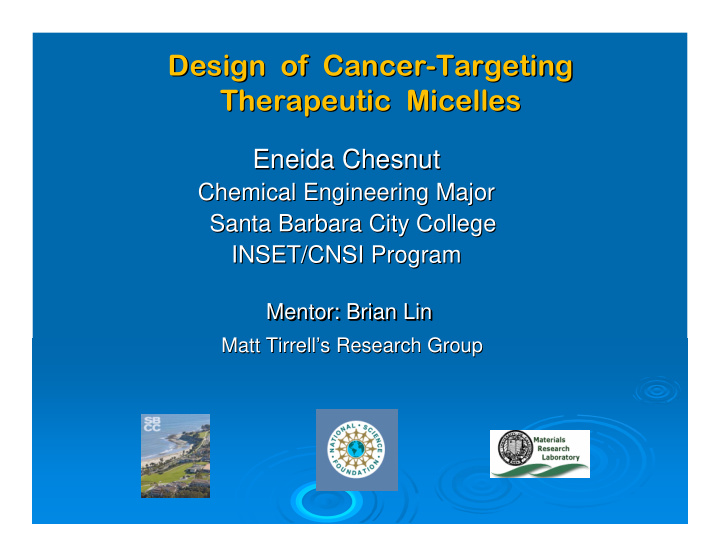



Design of Cancer- -Targeting Targeting Design of Cancer Therapeutic Micelles Therapeutic Micelles Eneida Chesnut Eneida Chesnut Chemical Engineering Major Chemical Engineering Major Santa Barbara City College Santa Barbara City College INSET/CNSI Program INSET/CNSI Program Mentor: Brian Lin Mentor: Brian Lin Mentor: Brian Lin Matt Tirrell’ ’s Research Group s Research Group Matt Tirrell
An Alternative Delivery System An Alternative Delivery System For Cancer Therapy For Cancer Therapy � Chemotherapy is highly toxic Chemotherapy is highly toxic � � Currently research is developing more effective ways Currently research is developing more effective ways � to deliver therapeutics to deliver therapeutics � Our Approach Our Approach � � Molecules that are able to target tumor cells Molecules that are able to target tumor cells � � Synthesis of peptide Synthesis of peptide- -amphiphiles that self amphiphiles that self- -assemble into micelles assemble into micelles � Micelles could be Micelles could be multifunctional: multifunctional: tumor cell tumor cell targeting and targeting and therapeutic therapeutic Courtesy of Amanda Trent
Surfactant Number Theory Surfactant Number Theory Theoretical approximation to predict Theoretical approximation to predict micro and nano structures micro and nano structures � Our goal is to conjugate Our goal is to conjugate � peptides to tails in a way that peptides to tails in a way that allows the resulting molecules allows the resulting molecules to self- to self -assemble into spherical assemble into spherical micelles. micelles. Cancer- -targeting targeting Cancer peptides peptides (Hydrophilic head) (Hydrophilic head) Hydrophobic Hydrophobic tail tail R.S. Tu, M. Tirrell / Advanced Drug Delivery Reviews 56 (2004) 1537–1563
1. Conjugation of a Peptide to a Hydrophobic Tail 1. Conjugation of a Peptide to a Hydrophobic Tail Thiol-ene reaction Tai Peptide O CH 2 l Cys Ala Arg Glu Lys Ala H 3 C NH DMPA UV light (2,2-dimethoxy-2-phenyl acetophenone) Tail-head group O H 3 C NH Cys Ala Arg Glu Lys Ala
2. High Performance Liquid Chromatography 2. High Performance Liquid Chromatography (HPLC) (HPLC) 4000 4000 Sparged 3500 3500 Reaction Increasing concentration 3000 3000 2500 2500 Relative intensity of acetonitrile 2000 2000 mAu mAu 1500 1500 Peaks correspond 1000 1000 to the tail-head group 500 500 0 0 -500 -500 0.0 2.5 5.0 7.5 10.0 12.5 15.0 17.5 20.0 22.5 25.0 27.5 30.0 32.5 35.0 37.5 40.0 42.5 45.0 47.5 50.0 52.5 55.0 57.5 60.0 M inutes Time 4000 4000 Sealed 3500 3500 3000 Reaction 3000 2500 2500 2000 2000 mAu mAu Tail-head group : 1500 1500 Tail-Cys (Gly) 7 Ala Arg Glu Lys Ala 1000 1000 500 500 0 0 -500 -500 0.0 2.5 5.0 7.5 10.0 12.5 15.0 17.5 20.0 22.5 25.0 27.5 30.0 32.5 35.0 37.5 40.0 42.5 45.0 47.5 50.0 52.5 55.0 57.5 60.0 Minutes
3. Mass Spectrometry 3. Mass Spectrometry � After separating the different molecules in our solution, After separating the different molecules in our solution, � through the HPLC, we collect the ones we are interested in to through the HPLC, we collect the ones we are interested in to analyze their molecular weight. analyze their molecular weight. � In order to do so, we use a mass spectrometer. In order to do so, we use a mass spectrometer. �
Tail-Cys Gly 7 Ala Arg Glu Lys Ala Molecular Weight: 1367.78 g/mol
Our Next Next Step: Step: Our Conjugate Two Peptides to One Tail Conjugate Two Peptides to One Tail Tail Peptide O Cys Ala Arg Glu Lys Ala CH 2 H 3 C N CH 2 DMPA UV light (2,2-dimethoxy-2-phenyl acetophenone) Tail-head group O H 3 C N Cys Ala Arg Glu Lys Ala Cys Ala Arg Glu Lys Ala
Acknowledgements Acknowledgements � Brian Lin, from Matt Tirrell’s Research Group � Dr. Nick Arnold and Dr. Jens Kuhn, from the INSET Program. � Evelyn Hu and Liu-Yen Kramer, from CNSI � Dr. Michael Young and Dr. Alexander Horwitz, from Santa Barbara City College
Thank you! Thank you! Any questions? Any questions?
DMPA (2,2-dimethoxy-2-phenyl acetophenone) is used as an initiator: O CH 3 O O CH 3 Under presence of UV light, cysteine will react with the tail (thiol-ene reaction): Cysteine (Cys) Glycine (Gly) Arginine (Arg) O O NH O H S OH OH NH 2 H 2 N NH OH NH 2 NH 2 Glutamic acid (Glu) Alanine (Ala) Lysine (Lys) NH 2 O O O H 3 C OH OH H O OH H 2 N NH 2 NH 2 O
Surfactant Number Number Theory Theory Surfactant Theoretical approximation Theoretical approximation to predict micro and nanostructures: to predict micro and nanostructures: v = Ns a l o v: volume of the tail group v: volume of the tail group a: head group area a: head group area l: fully extended l: fully extended hydrocarbon tail hydrocarbon tail R.S. Tu, M. Tirrell / Advanced Drug Delivery Reviews 56 (2004) 1537–1563
Recommend
More recommend